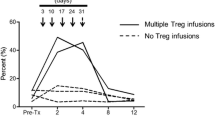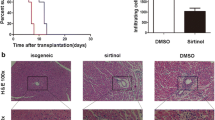Abstract
Peptides derived from the HLA dass I heavy chain (a.a. 75–84) have been shown to modulate irnmune responses in vitro and in vivo in a non-allele-restricted fashion. In vivo studies in rodents have demonstrated prolonged allograft survival foUowing peptide therapy. The immunomodulatory effect of these peptides has been correlated with peptide-mediated modulation of heme oxygenase 1 activity (HO-1). Recently, we used a rational approach for designing novel peptides with enhanced immunosuppressant activity. These peptides were also more potent inhibitors of HO-1 activity in vitro. Here we evaluated one of these peptides, RDP1258, for its ability to prolong heterotopic heart graft survival in rats. The peptide mediated effect on HO-1 was analyzed in vitro and in vivo. Peptide RDP1258 was shown to inhibit rat HO-1 in vitro in a dose-dependent fashion. However, RDP1258, like other HO-inhibitors, when administered to rats, secondarily resulted in an up-regulation of splenic HO-1 activity. Up-regulation of HO-1 was associated with prolonged heart allograft survival (6.6 ± 0.6 vs. 2/14 > 100 days and 12/14 16.2 ± 1.7 days; p < 0.001). The analysis of graft infiltrating cells on day 5 after transplantation showed a significant decrease in the number of graft infiltrating cells in RDP1258-treated recipients compared to untreated ones (14.8 vs. 32.7%; p < 0.01). In addition, grafts from peptide-treated animals showed significantly decreased expression of TNF-α mRNA and increased levels of iNOS mRNA. Our results are consistent with the recent observation that up-regulation of HO-1 results in the inhibition of several immune effector functions. Modulation of HO-1 activity may enable the development of novel immunomodulatory strategies in humans.







Similar content being viewed by others
References
Parham P, Clayberger C, Zorn SL, Ludwig DS, Schoolnik GK, Krensky AM. (1987) Inhibition of alloreactive cytotoxic T lymphocytes by peptides from the alpha 2 domain of HLA-A2. Nature325: 625–628.
Olson CA, Williams LC, McLaughlin-Taylor E, McMillan M. (1989) Creation of H-2 class I epitopes using synthetic peptides: recognition by alloreactive cytotoxic T lymphocytes. Proc. Natl. Acad. Sci. U.S.A.86: 1031–1035.
Clayberger C, Parham P, Rothbard J, Ludwig DS, Schoolnik GK, Krensky AM. (1987) HLA-A2 peptides can regulate cytolysis by human allogeneic T lymphocytes. Nature330: 763–765.
Clayberger C, Krensky AM. (1995) Immunosuppressive peptides corresponding to MHC class I sequences. Curr. Opin. Immunol.7: 644–648.
Clayberger C, Lyu SC, Pouletty P, Krensky AM. (1993) Peptides corresponding to T-cell receptor-HLA contact regions inhibit class I-restricted immune responses. Transplant. Proc.25: 477–478.
Cuturi MC, Josien R, Douillard P, et al. (1995) Prolongation of allogeneic heart graft survival in rats by administration of a peptide (a.a. 75–84) from the alpha 1 helix of the first domain of HLA-B7 01. Transplantation59: 661–669.
Buelow R, Veyron P, Clayberger C, Pouletty P, Touraine JL. (1995) Prolongation of skin allograft survival in mice following administration of AL-LOTRAP. Transplantation59: 455–460.
Buelow R, Burlingham WJ, Clayberger C. (1995) Immunomodulation by soluble HLA class I. Transplantation59: 649–654.
Nisco S, Vriens P, Hoyt G, et al. (1994) Induction of allograft tolerance in rats by an HLA class I-derived peptide and cyclosporine A. J. Immunol.152: 3786–3792.
Iyer S, Woo J, Cornejo MC, et al. (1998) Characterization and biological significance of immunosuppressive peptide D2702.75-84(E → V) binding protein. Isolation of heme oxygenase-1. J. Biol. Chem.273: 2692–2697.
Grassy G, Calas B, Yasri A, et al. (1998) In silico screening applied to the rational design of novel immunosuppressive compounds. Nat. Biotechnol.16: 748–752.
Kutty RK, Maines MD. (1981) Purification and characterization of biliverdin reductase from rat liver. J. Biol. Chem.256: 3956.
Ono K, Lyndsey ES. (1969) Improved technique of heart transplantation in rats. J. Thorac. Cardiovasc. Surg.57: 225–229.
Josien R, Pannetier C, Douillard P, et al. (1995) Graft infiltrating T helper cells, CD45RC phenotype, and Thl/Th2-related cytokines in donor specific transfusion-induced tolerance in adult rats. Transplantation60: 1131–1139.
Chirgwin JJ, Przbyla AE, MacDonald RJ, Rutter WJ. (1979) Isolation of biologically active ribonucleic acid from sources enriched in ribonuclease. Biochemistry18: 5294–5297.
Cuturi MC, Josien R, Douillard P, Giral M, Soulillou JP. (1996) Synthetic peptides derived from human MHC class I sequences delay allograft rejection in rodents and inhibit cell-mediated cytotoxicity in vivo and in vitro. Immunol. Rev.154: 5–20.
Rosenberg DW, Drummond DS, Kappas A. (1982) The influence of organometals on heme metabolism. In vitro and in vivo studies with organotins. Mol. Pharmacol.21: 150–158.
Maines M. (1984) New developments in the regulation of heme metabolism and their implications. CRC Cut. Rev. Toxicol.12: 241–314.
Maines M. (1997) The heme oxygenase system: a regulator of second messenger gases. Annu. Rev. Pharmacol. Toxicol.37: 517–554.
Seki T, Naruse M, Naruse K, et al. (1997) Roles of heme oxygenase/carbon monoxide system in genetically hypertensive rats. Biochem. Biophys. Res. Commun.241: 574–578.
Ye J, Laychock SG. (1998) A protective role for heme oxygenase expression in pancreatic islets exposed to interleukin-lbeta. Endocrinology139: 4155–4163.
Rodgers PA, Seidman DS, Wei PL, Dennery PA, Stevenson DK. (1996) Duration of action and tissue distribution of zinc protoporphyrin in neonatal rats. Pediatr. Res.39: 1041–1049.
Ny L, Aim P, Ekstrom P, Larsson B, Grundemar L, Andersson KE. (1996) Localization and activity of haem oxygenase and functional effects of carbon monoxide in the feline lower oesophageal sphincter. Br. J. Pharmacol.118: 392–399.
Woo J, Iyer S, Cornejo M, et al. (1998) Stress protein induced immunosuppression: inhibition of cellular immune effector functions following overexpression of heme oxygenase (HSP32). Transplant. Immunol6: 84–93.
Woo J, Gao L, Cornejo MC, Buelow R. (1995) A synthetic dimeric HLA class I peptide inhibits T cell activity in vitro and prolongs allogeneic heart graft survival in a mouse model. Transplantation60: 1156–1163.
Gao L, Woo J, Buelow R. (1996) Both l- and d-isomers of allotrap 2702 prolong cardiac allograft survival in mice. J. Heart Lung Transplant.15: 78–87.
Murphy B, Kim KS, Buelow R, Sayegh MH, Hancock WW. (1997) Synthetic MHC class I peptide prolongs cardiac survival and attenuates transplant arteriosclerosis in the Lewis→ Fischer 344 model of chronic allograft rejection. Transplantation64: 14–19.
Hanaway MJ, Geissler EK, Wang J, Fechner JH, Jr, Buelow R, Knechtle S J. (1996) Immunosuppressive effects of an HLA class I-derived peptide in a rat cardiac allograft model. Transplantation61: 1222–1228.
Agarwal A, Younki K, Matas A, Alam J, Nath K. (1996) Gas generating systems in acute renal allograft rejection in the rat. Transplantation61: 93–98.
Durante W, Kroll M, Christodoulides N, Peyton K, Schäfer A. (1997) Nitric oxide induces heme oxygenase-1 gene expression and carbon monoxide production in vascular smooth muscle cells. Circ. Res.80: 557–564.
Kurata S, Matsumoto M, Ymashita U. (1996) Concomitant transcriptional activation of nictric oxide synthase and heme oxygenase genes during nitric oxide-mediated macrophage cytostasis. J. Biochem.120: 49–52.
Takahashi K, Hara E, Ogawa K, Kimura D, Fujita H, Shibahara S. (1997) Possible implications of the induction of human heme oxygenase-1 by nitric oxide donors. J. Biochem.121: 1161–1168.
Alexander J, Valente J, Greenberg N, et al. (1998) Dietary omega-3 and omega-9 fatty acids uniquely enhance allograft survival in cyclosporine-treated and donor-specific transfusion-treated rats. Transplantation65: 1304–1309.
Shears L, Kawaharada N, Tzeng E, et al. (1997) Inducible nitric oxide synthase suppresses the development of allograft arteriosclerosis. J. Clin. Invest.100: 2035–2042.
Willis D, Moore AR, Frederick R, Willoughby DA. (1996) Heme oxygenase: a novel target for the modulation of the inflammatory response. Nat. Med.2: 87.
Otterbein L, Sylvester S, Choi A. (1995) Hemoglobin provides protection against lethal endotoxemia in rats: the role of heme oxygenase-1. Cell. Mol. Biol.13: 595–601.
Vogt B, Shanley T, Croatt A, Alam J, Johnsons K, Nath K. (1996) Glomerular inflammation induces resistance to tubular injury in the rat. J. Clin. Invest.98: 2139–2145.
Schwarzman M, Abraham N, Conners M, Dunn M, Levere R, Kappas A. (1997) Heme oxygenase induction with attenuation of experimentally induced corneal inflammation. Biochem. Pharmacol.53: 1069–1075.
Novogrodsky A, Suthanthiran M, Stenzel K. (1989) Immune stimulatory properties of metalloporphyrins. J. Immunol.143: 3981–3987.
Ignarro L, Ballot B, Wood K. (1984) Regulation of soluble guanylate cyclase activity by porphyrins and metalloporphyrins. J. Biol. Chem.209: 6201–6207.
Wolff D, Naddelman R, Lubeskie A, Saks D. (1996) Inhibition of nitric oxide synthase isoforms by porphyrins. Arch. Biochem. Biophys.333: 27–34.
Nakagami T, Toyomura K, Kinoshita T, Morisawa S. (1993) A beneficial role of bile pigments as an endogenous tissue protector: anti-complement effects of biliverdin and conjugated bilirubin. Biochem. Biophys. Acta1158: 189–193.
Haga Y, Tempero A, Kay D, Zetterman R. (1996) Intracellular accumulation of unconjugated bilirubin inhibits phytohemagglutinin-induced proliferation and interleukin-2 production of human lymphocytes. Digest. Dis. Sci.41: 1468–1474.
Haga Y, Tempero M, Zetterman R. (1996) Unconjugated bilirubin inhibits in vitro major histocompatibility complex-unrestricted cytotoxicity in human lymphocytes. Biochem. Biophys. Acta1316: 29–34.
Verma A, Hirsch D, Glatt C, Ronnett G, Synder S. (1993) Carbon monoxide: a putative neural messenger. Science259: 381–384.
Brüne B, Ulrich V. (1987) Inhibition of platelet aggregation by carbon monoxide is mediated by activation of guanylate cyclase. Mol. Pharmacol.32: 497–504.
Diaz J, Vara E, Garcia C, Villa N, Balibrea J. (1995) Evidence for a cyclic guanosine monophosphate-dependent, carbon monoxide-mediated, signaling system in the regulation of TNF-α production by human pulmonary macrophages. Arch. Surg.130: 1287–1293.
Vaandrager A, de Jonge H. (1996) Signalling by cGMP-dependent protein kinases. Mol. Cell. Biochem.157: 23–30.
Lincoln T, Komalavilas P, Boerth N, MacMillan-Crow L, Cornwell T. (1995) cGMP signalling through cAMP- and cGMP-dependent protein kinases. Adv. Pharmacol.34: 305–322.
Finn J, Grunwald M, Yau K. (1996) Cyclic nucleotide-gated ion channels: an extended family with diverse functions. Annu. Rev. Physiol.58: 395–426.
Acknowledgments
The authors would like to thank Helga Smit, Valia Proust, and Claire Usai for their excellent work in heart allograft peptide therapy and animal care.
Author information
Authors and Affiliations
Corresponding author
Rights and permissions
About this article
Cite this article
Cuturi, M.C., Christoph, F., Woo, J. et al. RDP1258, a New Rationally Designed Immunosuppressive Peptide, Prolongs Allograft Survival in Rats: Analysis of Its Mechanism of Action. Mol Med 5, 820–832 (1999). https://doi.org/10.1007/BF03401995
Accepted:
Published:
Issue Date:
DOI: https://doi.org/10.1007/BF03401995




